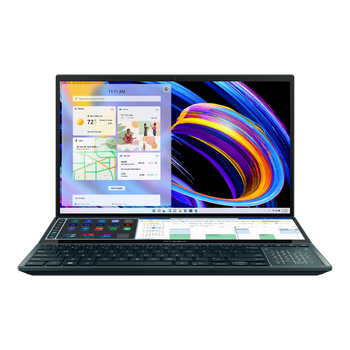- Powerful performance
- Excellent display quality
- Durable build
- Long battery life
- Exceptional dual-screen experience
- Powerful performance for creative tasks
- Stunning main OLED display
- Great audio quality
- Premium pricing
- Limited port selection
- Heavy and bulky
- Short battery life
Dell XPS 13 (2024) vs ASUS ZenBook Pro Duo 15 OLED
The world of ultrabooks has witnessed significant advancements in recent years, with manufacturers continually pushing the boundaries of innovation and design. Two notable examples of this trend are the Dell XPS 13 (2024) and the ASUS ZenBook Pro Duo 15 OLED. While both devices belong to the esteemed category of ultrabooks, they cater to different needs and offer distinct features that set them apart from one another.
Design and Display
The Dell XPS 13 (2024) boasts a sleek and compact design, weighing in at approximately 2.7 pounds and measuring just 0.33 inches thick. Its InfinityEdge display is a stunning 13.4-inch Full HD+ touchscreen, offering vibrant colors and crisp visuals. The bezel-less design provides an immersive viewing experience, making it perfect for watching movies, browsing the web, or working on documents.
In contrast, the ASUS ZenBook Pro Duo 15 OLED takes a different approach with its design. This ultrabook features a larger 15.6-inch 4K OLED display, which is not only bigger but also offers more vivid colors and deeper blacks. The unique aspect of this device is the secondary 14-inch 4K touchscreen display situated above the keyboard, providing an additional canvas for multitasking, note-taking, or referencing information while working on the primary screen.
Performance
Both ultrabooks are equipped with powerful processors from Intel's latest generation, ensuring seamless performance and efficient multitasking. The Dell XPS 13 (2024) comes with up to a 12th Gen Intel Core i9 processor, paired with up to 64GB of RAM and a 2TB SSD. This configuration makes it ideal for demanding tasks like video editing, software development, and data analysis.
The ASUS ZenBook Pro Duo 15 OLED, on the other hand, is powered by up to a 12th Gen Intel Core i9 processor as well, but it can be configured with up to 64GB of RAM and a 4TB SSD. The additional screen and larger form factor allow for more extensive cooling systems, which might provide better thermal management during intense workloads.
Portability and Battery Life
As an ultrabook, the Dell XPS 13 (2024) excels in portability, with its lightweight design and compact footprint making it easy to carry around. Its battery life is also impressive, with up to 12 hours of web browsing or video playback on a single charge.
The ASUS ZenBook Pro Duo 15 OLED, despite its larger size, still manages to maintain a relatively slim profile and weighs around 3.9 pounds. While not as lightweight as the XPS 13, it is still portable enough for regular travel. Battery life is somewhat compromised due to the power-hungry dual screens, with up to 8 hours of usage on a single charge.
Target Audience
The Dell XPS 13 (2024) is geared towards individuals who prioritize portability, compact design, and everyday productivity. It's an excellent choice for students, freelancers, or business professionals who need a reliable and efficient ultrabook for tasks like email, web browsing, and document editing.
In contrast, the ASUS ZenBook Pro Duo 15 OLED is designed with creators and power users in mind. The dual screens provide unparalleled multitasking capabilities, making it an attractive option for graphic designers, video editors, software developers, and other professionals who require a high level of productivity and screen real estate.
Conclusion
In conclusion, both the Dell XPS 13 (2024) and the ASUS ZenBook Pro Duo 15 OLED are exceptional ultrabooks that cater to different needs and preferences. While the XPS 13 excels in portability and everyday productivity, the ZenBook Pro Duo 15 OLED offers unparalleled multitasking capabilities and a unique dual-screen experience. Ultimately, the choice between these two devices depends on your specific requirements and workflow. If you prioritize compact design and effortless portability, the Dell XPS 13 (2024) might be the better choice. However, if you're a creator or power user who demands more screen real estate and advanced multitasking features, the ASUS ZenBook Pro Duo 15 OLED is undoubtedly the superior option.

































